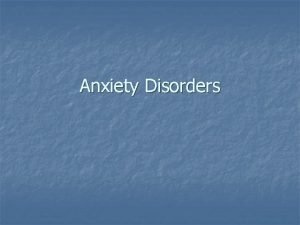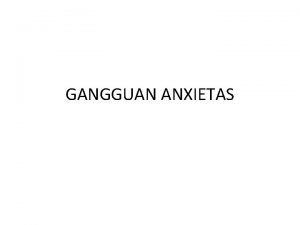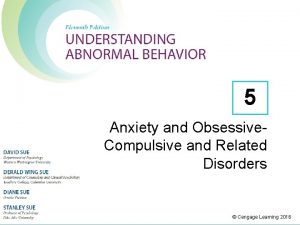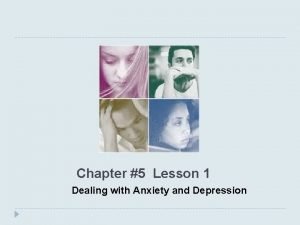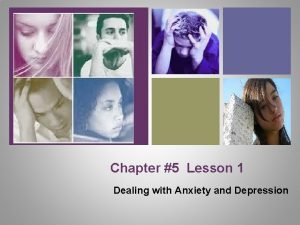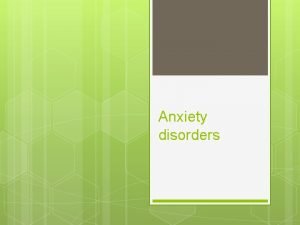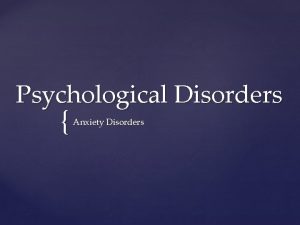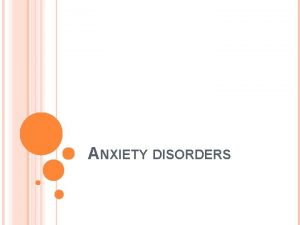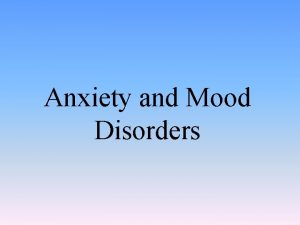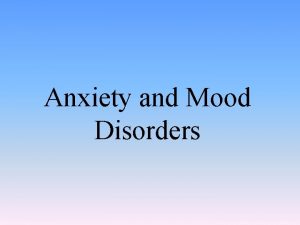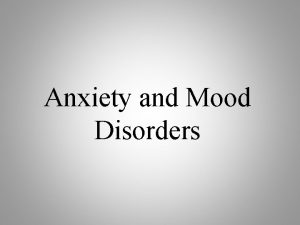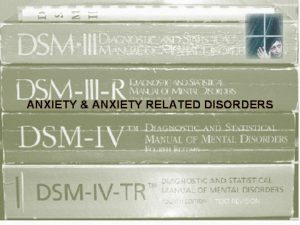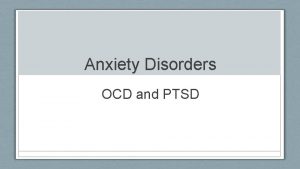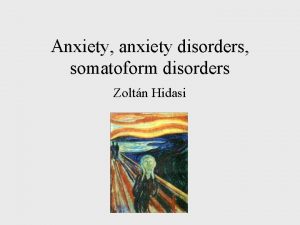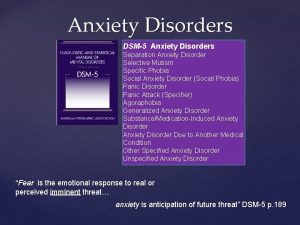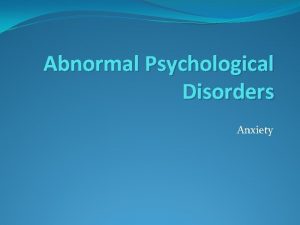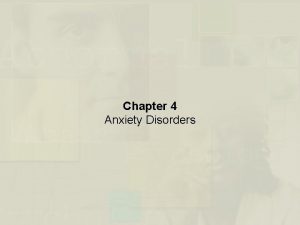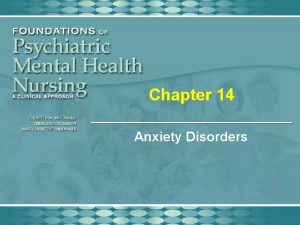Anxiety Disorders Chapter 4 Nature of Anxiety and















- Slides: 15


Anxiety Disorders Chapter 4

Nature of Anxiety and Fear n Anxiety n n n Future-oriented mood state characterized by marked negative affect Somatic symptoms of tension Apprehension about future danger or misfortune n Fear n n Present-oriented mood state, marked negative affect Immediate fight or flight response to danger or threat Strong avoidance/escapist tendencies Involves abrupt activation of the sympathetic nervous system n Anxiety and Fear are Normal Emotional States

From Normal to Disordered Anxiety and Fear n Characteristics of Anxiety Disorders n n n Psychological disorders – Pervasive and persistent symptoms of anxiety and fear Involve excessive avoidance and escapist tendencies Symptoms and avoidance causes clinically significant distress and impairment

The Anxiety Disorders: An Overview n Generalized Anxiety Disorder n Panic Disorder with and without Agoraphobia n Specific Phobias n Social Phobia n Posttraumatic Stress Disorder n Obsessive-Compulsive Disorder

Generalized Anxiety Disorder: The “Basic” Anxiety Disorder n Overview and Defining Features n n Excessive uncontrollable anxious apprehension and worry about life events Coupled with strong, persistent anxiety Somatic symptoms differ from panic (e. g. , muscle tension, fatigue, irritability) Persists for 6 months or more n Facts and Statistics n n 4% point prevalence Females outnumber males approximately 2: 1 Onset is often insidious, beginning in early adulthood Tendency to be anxious runs in families

Panic Disorder with and without Agoraphobia n Overview and Defining Features n n Experience of unexpected panic attack (i. e. , a false alarm) Develop anxiety, worry, or fear about having another attack or its implications Agoraphobia – Fear or avoidance of situations/events associated with panic Symptoms and concern about another attack persists for 1 month or more n Facts and Statistics n n n 3. 5% point prevalence Two thirds with panic disorder are female Onset is often acute, beginning between 25 and 29 years of age

The Phenomenology of Panic Attacks n What Is a Panic Attack? n n Abrupt experience of intense fear or discomfort Accompanied by several physical symptoms (e. g. , breathlessness, chest pain) n DSM-IV Subtypes of Panic Attacks n n n Situationally bound (cued) panic – Expected and bound to some situations Unexpected (uncued) panic – Unexpected “out of the blue” without warning Situationally predisposed panic – May or may not occur in some situations n Panic Is Analogous to Fear as an Alarm Response


Specific Phobias: An Overview and Defining Features n n n Extreme and irrational fear of a specific object or situation Markedly interferes with one's ability to function Recognize fears are unreasonable, but go to great lengths to avoid phobic objects n Facts and Statistics n n n About 11% point prevalence for one or more specific phobias Females are again over-represented Phobias run a chronic course, with onset beginning between 15 and 20 years of age

Social Phobia: An Overview and Defining Features n n Extreme and irrational fear/shyness in social and performance situations Markedly interferes with one's ability to function Often avoid social situations or endure them with great distress Generalized subtype – Social phobia across numerous social situations n Facts and Statistics n n n About 13% lifetime prevalence Females are slightly more represented than males Onset is usually during adolescence with a peak age of onset at about 15 years

Posttraumatic Stress Disorder (PTSD): An Overview and Defining Features n n n Requires exposure to an event resulting in extreme fear, helplessness, or horror Person continues to re-experience the event (e. g. , memories, nightmares, flashbacks) Avoidance of cues that remind person of event Emotional numbing and interpersonal problems are common Markedly interferes with one's ability to function PTSD diagnosis cannot be made earlier than 1 month posttrauma n Facts and Statistics n n About 7. 8% point prevalence Combat and sexual assault are the most common traumas

Obsessive-Compulsive Disorder (OCD): An Overview and Defining Features n n Obsessions – Intrusive and nonsensical thoughts, images, or urges that one tries to resist or eliminate Compulsions – Thoughts or actions to suppress the thoughts and provide relief Most persons with OCD display multiple obsessions Most persons with OCD present with cleaning and washing or checking rituals

Obsessive-Compulsive Disorder (OCD): Causes and Associated Features n Facts and Statistics n n About 2. 6% lifetime prevalence Most persons with OCD are female OCD tends to be chronic Onset is typically in early adolescence or young adulthood

 Chapter 15 anxiety and obsessive-compulsive disorders
Chapter 15 anxiety and obsessive-compulsive disorders Anxiety disorders def
Anxiety disorders def Icd 10 anxiety with panic attacks
Icd 10 anxiety with panic attacks Multipath model of anxiety disorders
Multipath model of anxiety disorders Chapter 8 managing stress and anxiety
Chapter 8 managing stress and anxiety Chapter 5 lesson 1 dealing with anxiety and depression
Chapter 5 lesson 1 dealing with anxiety and depression Chapter 5 lesson 1 dealing with anxiety and depression
Chapter 5 lesson 1 dealing with anxiety and depression Nature and nature's law lay hid in night
Nature and nature's law lay hid in night Define a primary skin lesion and list three types
Define a primary skin lesion and list three types Chapter 6 musculoskeletal system
Chapter 6 musculoskeletal system Chapter 46 digestive and endocrine disorders
Chapter 46 digestive and endocrine disorders Types of somatic disorder
Types of somatic disorder Chapter 29 endocrine and metabolic disorders
Chapter 29 endocrine and metabolic disorders Chapter 21 mental health diseases and disorders
Chapter 21 mental health diseases and disorders Chapter 18 eating and feeding disorders
Chapter 18 eating and feeding disorders Chapter 17 reproductive system diseases and disorders
Chapter 17 reproductive system diseases and disorders

